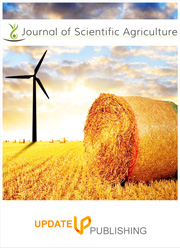Antifungal activity of turmeric rhizome extract against Ganoderma boninense
DOI:
https://doi.org/10.25081/jsa.2024.v8.9292Keywords:
Ganoderma boninense, Turmeric rhizome extract, Antifungal propertiesAbstract
Basal stem rot (BSR) caused by Ganoderma boninense threatens the oil palm industry, particularly in Southeast Asia. This study evaluated methanol extracts of turmeric rhizome (TRE) from four ecotypes (Bangka, Bandung, Palembang, and Surabaya) for antifungal activity against G. boninense. TRE showed strong inhibition, with a minimum inhibitory concentration (MIC) of 0.31% and IC50 values between 0.93% and 1.92%, exhibiting dose-dependent effects. Treated fungal hyphae displayed morphological abnormalities with enhanced chitin and protein deposition. Elevated electrical conductivity in fungal culture media indicated membrane damage and leakage of intracellular contents. These findings highlight the potential of TRE as a sustainable alternative to chemical fungicides for BSR management.
Downloads
References
Akter, J., Hossain, M. A., Sano, A., Takara, K., Islam, M. Z., & Hou, D.-X. (2018). Antifungal activity of various species and strains of turmeric (Curcuma spp.) against (Fusarium solani) sensu lato. Pharmaceutical Chemistry Journal, 52, 320-325. https://doi.org/10.1007/s11094-018-1815-4
Akter, J., Islam, M. Z., Takara, K., Hossain, M. A., & Sano, A. (2019). Isolation and structural elucidation of antifungal compounds from Ryudai gold (Curcuma longa) against Fusarium solani sensu lato isolated from American manatee. Comparative Biochemistry and Physiology Part C: Toxicology & Pharmacology, 219, 87-94. https://doi.org/10.1016/j.cbpc.2019.02.011
Baharon, M. N., Zulkifli, N. S. A., Baharom, N. A., & Yunus, S. M. (2019). Antifungal activity of selected plant extracts against Curvularia sp. infecting local purple sweet potato (Ipomoea batatas). Malaysian Journal of Microbiology, 15(4), 342-345. https://doi.org/10.21161/mjm.1915411
Huang, L., Zhang, J., Song, T., Yuan, L., Zhou, J., Yin, H., He, T., Gao, W., Sun, Y., Hu, X., & Huang, H. (2016). Antifungal curcumin promotes chitin accumulation associated with decreased virulence of Sporothrix schenckii. International Immunopharmacology, 34, 263-270. https://doi.org/10.1016/j.intimp.2016.03.010
Kamu, A., Phin, C. K., Seman, I. A., Gabda, D., & Mun, H. C. (2020). Estimating the yield loss of oil palm due to Ganoderma basal stem rot disease by using Bayesian model averaging. Journal of Oil Palm Research, 33(1), 46-55. https://doi.org/10.21894/jopr.2020.0061
Kumar, A., Dhamgaye, S., Maurya, I. K., Singh, A., Sharma, M., & Prasad, R. (2014). Curcumin targets cell wall integrity via calcineurin-mediated signaling in Candida albicans. Antimicrobial Agents and Chemotherapy, 58(1), 167-175. https://doi.org/10.1128/AAC.01385-13
Munandar, R. P., Suwandi, S., & Suparman, S. (2021). Pengaruh tumpangsari dengan tanaman rimpang terhadap infeksi awal Ganoderma boninense pada bibit kelapa sawit (Elaeis guineensis). Sainmatika: Jurnal Ilmiah Matematika Dan Ilmu Pengetahuan Alam, 18(1), 34. https://doi.org/10.31851/sainmatika.v17i3.5738
Neelofar, K., Shreaz, S., Rimple, B., Muralidhar, S., Nikhat, M., & Khan, L. A. (2011). Curcumin as a promising anticandidal of clinical interest. Canadian Journal of Microbiology, 57(3), 204-210. https://doi.org/10.1139/W10-117
Rahmadhani, T. P., Suwandi, S., & Pujiastuti, Y. (2018). Growth response of Ganoderma sp. mycelium treated with root exudates of herbaceous plants. BIOVALENTIA: Biological Research Journal, 4(1), 28-31. https://doi.org/10.24233/BIOV.4.1.2018.88
Rahmadhani, T. P., Suwandi, S., & Suparman, S. (2020). Growth responses of oil palm seedling inoculated with Ganoderma boninense under competition with edible herbaceous plants. Journal of Scientific Agriculture, 4, 45-49. https://doi.org/10.25081/jsa.2020.v4.6231
Suwandi, S., Munandar, R. P., Suparman, S., Irsan, C., & Muslim, A. (2023). Mixed planting with rhizomatous plants interferes with Ganoderma disease in oil palm. Journal of Oil Palm Research, 35(2), 354-364. https://doi.org/10.21894/jopr.2022.0043
Suwandi, S., Rahmadhani, T. P., Suparman, S., Irsan, C., & Muslim, A. (2022). Allelopathic potential of root exudates from perennial herbaceous plants against Ganoderma boninense. IOP Conference Series: Earth and Environmental Science, 976(1), 012053. https://doi.org/10.1088/1755-1315/976/1/012053
Tang, X., Shao, Y.-L., Tang, Y.-J., & Zhou, W.-W. (2018). Antifungal activity of essential oil compounds (geraniol and citral) and inhibitory mechanisms on grain pathogens (Aspergillus flavus and Aspergillus ochraceus). Molecules, 23(9), 2108. https://doi.org/10.3390/molecules23092108
Upasani, M. L., Gurjar, G. S., Kadoo, N. Y., & Gupta, V. S. (2016). Dynamics of colonization and expression of pathogenicity related genes in Fusarium oxysporum f.sp. ciceri during chickpea vascular wilt disease progression. Plos One, 11(5), e0156490. https://doi.org/10.1371/journal.pone.0156490
Yuan, T., Hua, Y., Zhang, D., Yang, C., Lai, Y., Li, M., Ding, S., Li, S., & Chen, Y. (2024). Efficacy and antifungal mechanism of rosemary essential oil against Colletotrichum gloeosporioides. Forests, 15(2), 377. https://doi.org/10.3390/f15020377
Zakaria, L. (2023). Basal stem rot of oil palm: the pathogen, disease incidence, and control methods. Plant Disease, 107(3), 603-615. https://doi.org/10.1094/PDIS-02-22-0358-FE
Published
How to Cite
Issue
Section
Copyright (c) 2024 Lidya Karlina, Suwandi Suwandi, A. Muslim, Nurhayati Damiri, Abdul Madjid Rohim, Zaidan P. Negara

This work is licensed under a Creative Commons Attribution-NonCommercial-NoDerivatives 4.0 International License.



 .
.